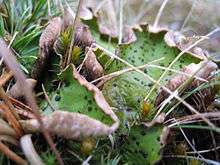Peltigera aphthosa
Peltigera aphthosa is a species of lichen known by the common names green dog lichen, leafy lichen, felt lichen, and common freckle pelt. It has a circumpolar distribution, occurring throughout the Arctic, boreal, and temperate regions of the Northern Hemisphere.[1]
| Peltigera aphthosa | |
|---|---|
 | |
| Scientific classification | |
| Kingdom: | |
| Division: | |
| Class: | |
| Order: | |
| Family: | |
| Genus: | |
| Species: | P. aphthosa |
| Binomial name | |
| Peltigera aphthosa | |
| Synonyms | |
| |
This lichen has a large thallus that may exceed one meter in width. It is divided into lobes up to about 10 centimeters long and 6 wide. It is green, becoming pale as it dries. The thallus is dotted with cephalodia, which contains one of the two symbionts, a species of Nostoc. The other is a species of Coccomyxa. These perform photosynthesis, and the Nostoc also fixes nitrogen. The lichen produces large apothecia, a reproductive structure.[1]
This widespread lichen grows in a variety of habitat types, including Arctic ecosystems. It grows in alpine climates in the southern parts of its distribution.[1]
This lichen was noted to absorb aluminum and silicon from the ash released from the 1980 eruption of Mount St. Helens.[1]
| Wikimedia Commons has media related to Peltigera aphthosa. |
References
- Matthews, Robin F. 1993. Peltigera aphthosa. In: Fire Effects Information System, [Online]. U.S. Department of Agriculture, Forest Service, Rocky Mountain Research Station, Fire Sciences Laboratory.
External links
Further reading
- Palmqvist, K. (1993). Photosynthetic C02-use efficiency in lichens and their isolated photobionts: the possible role of a C02-concentrating mechanism. Planta 191 48-56.
- Paulsrud, P., et al. (1998). Cyanobiont specificity in some Nostoc-containing lichens and in a Peltigera aphthosa photosymbiodeme. New Phytologist 139 517-24.
- Paulsrud, P., et al. (2001). Field investigations on cyanobacterial specificity in Peltigera aphthosa. New Phytologist 152 117-23.
